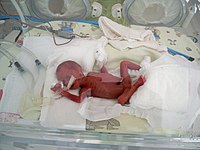
Photo from wikipedia
ObjectiveThe aim of this study was to explore the role of the lectin pathway in neonatal sepsis through the study of MBL and MASP2 levels and their relationship with infection… Click to show full abstract
ObjectiveThe aim of this study was to explore the role of the lectin pathway in neonatal sepsis through the study of MBL and MASP2 levels and their relationship with infection in a cohort of very-low-birth-weight infants (VLBWI).MethodsMBL and MASP2 were measured in plasma samples of n = 89 VLBWI using ELISA and correlated with clinical parameters. MBL plasma levels were aligned with genotyping data of mbl2 exon 1 polymorphisms, rs1800450, rs1800451, and rs5030737.ResultsMBL levels were clearly determined by MBL genotype, i.e., AA individuals had tenfold higher MBL levels than AO individuals. MBL and MASP2 levels did not correlate with gestational age, apart from MASP2 levels on day 7. During the first 21 days of life, we noted a gradual increase in both MBL and MASP2 levels. On day 7 of life, MASP2 levels in infants developing late-onset sepsis measured before the onset of symptoms were found to be lower, as compared to non-LOS infants.ConclusionsIn our cohort of VLBWI, MBL levels were genetically determined, but not associated with gestational age or sepsis in the first 21 days of life. Lower MASP2 levels on day 7 may indicate increased risk for late-onset infection.
Journal Title: Pediatric Research
Year Published: 2018
Link to full text (if available)
Share on Social Media: Sign Up to like & get
recommendations!